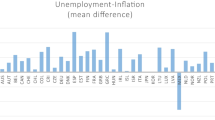Abstract
Unit root, co-integration, and Granger Causality are used to test specification of a generalized time series model of mortgage choice. Unit root tests determine that both the fixed-adjustable spread (FAsp) and the proportion of ARM originations (AP) are first difference stationary. The cointegrating vector between FAsp and AP was found to be weak, raising questions regarding their “long-term relationship.” Causality tests determined that ARM originations Granger causes the fixed-adjustable mortgage spread (AP→FAsp) rather than FAsp→AP. This result suggests that mortgage originators adjust the current FAsp spread based on last periods allocation. The coefficient vector for this specification was unstable and became increasingly negative during the 1980s.
Similar content being viewed by others
References
Boyd, James. (1988). “Asset Status Proxies and Consumer Preference for ARMs: An Empirical Investigation Using Probit Analysis,”Journal of Real Estate Research, Spring, 37–49.
Brueckner, Jan, and James Follain. (1988). “The Rise and Fall of the ARM: An Econometric Analysis of Mortgage Choice,”Review of Economics and Statistics, Vol. 70.
Choi, S., and M. Wohar. (1991). “New Evidence Concerning the Expectations Theory for the Short End of the Maturity Spectrum,”The Journal of Financial Research 14, 1, Spring, 83–92.
Devaney, Mike, Karen Pickerill, and Fred Krause. (1992). “Co-integration and Causal Relations in Mortgage and Capital Markets,”Journal of Financial Services Research 5, 341–353.
Dhillon, Upinder, James Shilling, and C.F. Sirmans. (1987). “Choosing Between Fixed and Adjustable Rate Mortgages,”Journal of Money Credit and Banking, 19, May, 260–267.
Dickey, D., and S. Pantula. (1987). “Determining the Order of Differencing in Autoregressive Processes,”Journal of Business and Economic Statistics, 5, October, 455–461.
Engle, Robert, and Clive Granger. (1987). “Co-integration and Error Correction Representation, Estimation and Testing,”Econometrica 55, 2, March.
Engle, Robert, and B. Yoo. “Forecasting and Testing in Co-integrated Systems,”Journal of Econometrics 35, May, 143–159.
Froot, Kenneth. (1989). “New Hope for the Expectations Hypothesis of the Term Structure,”Journal of Finance 44, 2, 283–305.
Fuller, William. (1976).Introduction to Statistical Time Series. New York, NY: Wiley Publications.
Gardner, Mona, Han Kang, and Dixie Mills. (1987). “Consumer Profiles and Acceptance of ARM Features: An Application of Logit Regression,”Journal of Real Estate Research 2, 63–74.
Goldberg, L. and Andrea Heuson. (1990). “Fixed vs. Variable Rate Financing: The Influence of Borrower, Lender and Market Characteristics,” paper presented at the Financial Management Association, Fall.
Granger, Clive. (1969). “Investigating Causal Relations by Econometric Models and Cross-Spectral Methods,”Econometrica July.
Hakkio, Craig, and Mark Rush. (1990). “Co-integration: How Short is the Long Run?”Research Working Paper. Federal Reserve Bank of Kansas City, December.
Horowitz, M. (1985).Economic Determinants of Residential Mortgage Choice, Ph.D. dissertation, Portland State University.
LeSage, J. (1990). “A Comparison of the Forecasting Ability of ECM and VAR Models,”Review of Economics and Statistics 72, 4, November, 664–671.
Levinson, M., and D. McGinn. (1992). “The Golden Goose Bites Back: The Refinancing Boom Roils the Mortgage Market,”Newsweek August 24, p. 56.
MacDonal, Ronald, and Adam Speight. (1988). “The Term Structure of Interest Rates in the UK,”Bulletin of Economic Research 40, (4), 287–299.
McEnally, Richard. (1983). “The Term Structure of Interest Rates.” In theHandbook of Fixed Income Securities, (F. Fabozzi and I. Pollack, eds.). Homewood, Illinois: Dow Jones.
McFayden, James, Karen Pickerill, and Mike Devaney. (1991). “The Expectations Hypothesis of the Term Structure: More Evidence,”Journal of Economics and Business 43, 89.
Nothaft, Frank, and George Wang. (1992). “Determinants of the ARM Share of National and Regional Lending,”Journal of Real Estate Finance and Economics 5, 2, June, 219–234.
Palash, Carl, and Robert Stoddard. (1985). “ARMs: Their Financing Rate and Impact on Housing,”Federal Reserve Bank of New York Quarterly Review Autumn, 39–49.
Sa-Aadu, J., and C.F. Sirmans. (1987). “The Choice Between Fixed and Adjustable-Rate Mortgages,” Department of Finance, College of Business Administration, Louisiana State University, Baton Rouge, LA, June.
Seiders, D. and G. Mills. (1985). “Rates, Terms, and Insurance Coverage on ARMs: Their Role in Recent Lending Activity and Implications for the Future.” Presented at the Eastern Economics Association, March 21.
Sims, C. (1980). “Macroeconomics and Reality,”Econometrica Vol. 48.
Wessel, D., and T. Vogel, (1993). “Arcane World of Bonds is Guide and Beacon to a Populist President,”The Wall Street Journal February 25.
Author information
Authors and Affiliations
Rights and permissions
About this article
Cite this article
Devaney, M. Time series models of mortgage choice: Evidence of lender influence. J Real Estate Finan Econ 8, 245–257 (1994). https://doi.org/10.1007/BF01096995
Issue Date:
DOI: https://doi.org/10.1007/BF01096995




